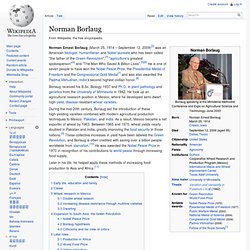

Green Revolution — www.gktoday.in — Readability. The Green Revolution increased in production needed to make India self-sufficient in food grains.

These three measures adopted for the improvement of agriculture, food grain production in India increased by 25% in 1967-68 as compared to 1966-67. It was a revolution because of so much increase in the production in just one year. The term "Green Revolution" was first used in 1968 by then USAID director William Gaud. Was Green Revolution confined to India?
No, It started from Mexico with the efforts of Dr. Who was Dr. Dr. How Norman's efforts in Mexico expanded? M. S. Swaminathan. Norman Borlaug. Norman Ernest Borlaug (March 25, 1914 – September 12, 2009)[2] was an American biologist, humanitarian and Nobel laureate who has been called "the father of the Green Revolution",[3] "agriculture's greatest spokesperson"[4] and "The Man Who Saved A Billion Lives".[5][6] He is one of seven people to have won the Nobel Peace Prize, the Presidential Medal of Freedom and the Congressional Gold Medal[7] and was also awarded the Padma Vibhushan, India's second highest civilian honor.[8] During the mid-20th century, Borlaug led the introduction of these high-yielding varieties combined with modern agricultural production techniques to Mexico, Pakistan, and India.

As a result, Mexico became a net exporter of wheat by 1963. Later in his life, he helped apply these methods of increasing food production to Asia and Africa.[11] Early life, education and family[edit] Borlaug had the great-grandchild of Norwegian immigrants to the United States. "Wrestling taught me some valuable lessons ... High Yielding Variety Programme — www.gktoday.in — Readability. High Yielding Variety Programme (HYVP): 1966-67 The High Yielding Variety Programme (HYVP) was launched in the Kharif of 1966-67 with an objective to attain self-sufficiency in food by 1970-71.

The core philosophy of the programme was to increase the productivity of food grains by adopting latest varieties of inputs of crops. Introduction of new high yielding varieties of improved seeds and enhanced application of the fertilizers and extended use of pesticides were its main features. Short Notes on Credit Authorisation Scheme of Credit — www.preservearticles.com — Readability.
The Credit Authorisation Scheme (CAS) for bank advances was introduced by the Reserve Bank of India in 1965.

Under the Scheme, all scheduled commercial banks have to obtain prior authorisation of the Reserve Bank before granting any fresh credit limit of Rs. 1 crore or more to any single borrower. This limit was, however, raised to Rs. 2 crores in 1975. The banks first scrutinise the proposals of the borrowers and then send them to the Reserve Bank for approval.
The Reserve Bank goes through the proposal and if found suitable, then it may authorise the concerned bank to sanction the loans asked for. Intensive Agriculture Development program — www.gktoday.in — Readability. Intensive Agriculture Development program (IADP) Intensive Agriculture Development program (IADP) was the first major experiment of Indian government in the field of agriculture and it was also known as a "package programme" as it was based upon the package approach.

The core philosophy was to provide loan for seeds and fertilizers to farmers. Intensive Agriculture Development program was started with the assistance of Ford Foundation. It was launched as pilot basis in one district of 7 states at that time. These 7 districts were: Thanjavur (Tamil Nadu) West Godavari (Andhra Pradesh) Shahabad (Bihar) Raipur (Madhya Pradesh) Aligarh (Uttar Pradesh) Ludhiana (Punjab) Pali (Rajasthan) The BDOs and VLWs were made double in number and "Agriculture Extension Officers" were appointed.
Notes on the structure of community development programme in India — www.preservearticles.com — Readability. Community development programme being one of the most priorities in the planning of the country has drawn the attention of thinkers, leaders and administrators.

There have been constant trials to develop an organisational pattern which will be able to keep vertical as well horizontal relationship between people and government machinery at all levels from village to country. Thus its organisatiooal pattern has been changing from time to time. Again, as per the recommendation of the Mehta team, it was left to the state government, to work out the organisational pattern is accordance with their own practices and consonance with local administration, the centre is only to lay down the policy and prescribe broad outlines. Hence a variation is marked in its organisation in different states.
However a common pattern of structure can be traced because more or less the functions are same, aim and objective is one. At an initial stage, the programme had a central committee at the national level.